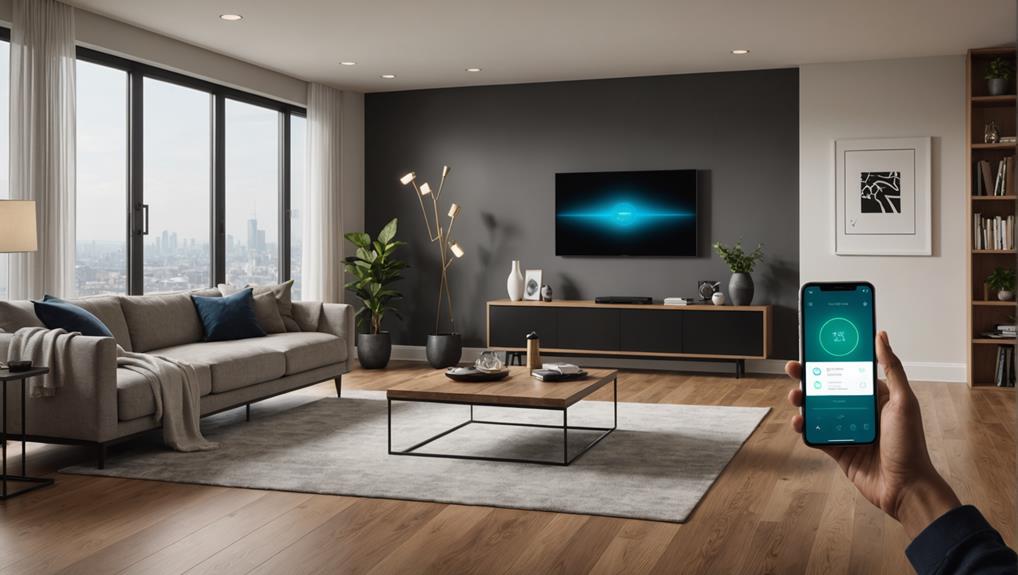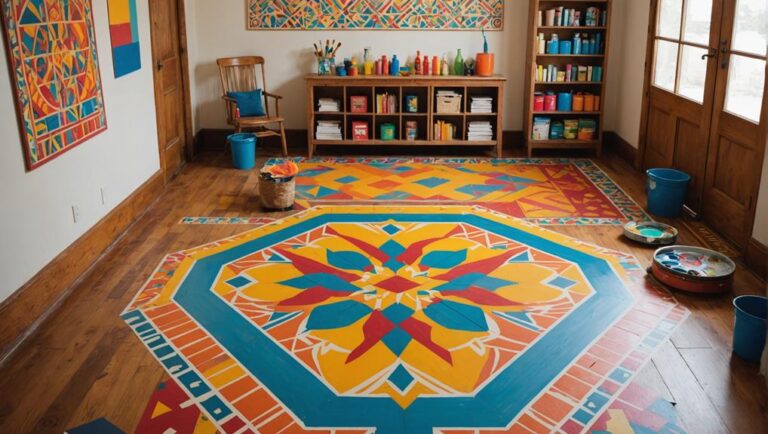Integrating floor sensors with smart home systems greatly enhances your home's safety, monitoring, and automation. These sensors provide real-time data on foot traffic and occupancy, allowing for improved energy management and safety features like fall detection. To achieve seamless integration, select compatible sensors, install them in key areas, and follow pairing instructions with your smart home hub. This setup not only automates your lighting and HVAC systems based on occupancy but also offers extensive security monitoring. By understanding the benefits and capabilities of this integration, you can optimize your smart home for a more responsive living environment.
Overview of Floor Sensors
When it comes to enhancing smart home systems, floor sensors play an essential role in providing real-time data about foot traffic and occupancy. These devices utilize advanced sensor technologies to monitor activity in specific areas of your home, offering critical insights that can improve safety and security. By detecting the presence or absence of individuals, floor sensors can help you better manage your living environment.
Floor monitoring is key in various scenarios, such as ensuring that children or pets are safe, preventing unauthorized access, or optimizing energy usage based on occupancy. Many modern floor sensors are designed to integrate seamlessly with existing smart home systems, allowing for centralized control and automation. This integration also enables other smart devices, like lights and alarms, to respond appropriately to floor sensor data.
The technologies behind these sensors include pressure sensors, infrared sensors, and even advanced motion detection systems. Each type has its advantages; for instance, pressure sensors can provide immediate notifications when someone steps on them, while infrared sensors can detect movement without direct contact.
Incorporating floor sensors into your smart home system not only enhances your home's intelligence but also contributes to a safer living environment. By having reliable data on foot traffic patterns, you can make informed decisions about security measures and energy consumption, ensuring your home remains a secure and efficient space.
Benefits of Integration
Integrating floor sensors with your smart home system greatly enhances automation capabilities, allowing for seamless interactions between devices. You'll also benefit from improved safety features, as these sensors can detect falls or unexpected movements, alerting you or emergency services if necessary. This integration not only streamlines your daily routines but also fosters a safer living environment.
Enhanced Home Automation
By seamlessly connecting floor sensors with smart home systems, you can greatly enhance your home automation experience. This integration allows for real-time monitoring of your home environment, enabling you to make informed decisions based on precise data. Proper sensor placement is vital; strategically positioning these sensors guarantees thorough coverage of key areas while minimizing blind spots. You'll gain insights into foot traffic patterns, allowing you to optimize energy usage and automate lighting based on occupancy.
Moreover, this integration enhances your ability to manage various devices through a centralized system, streamlining your daily routines. For instance, when a sensor detects movement, it can trigger smart lights or adjust the thermostat, creating a responsive living space tailored to your needs.
While focusing on convenience, it is important to prioritize data privacy. Making sure that your smart home system has robust security measures in place protects your information from unauthorized access. By integrating floor sensors into your smart home ecosystem, not only do you improve efficiency, but you also maintain control over your home environment, all while keeping safety and privacy at the forefront of your automation strategy.
Improved Safety Features
One of the key benefits of integrating floor sensors into your smart home system is the significant enhancement of safety features. These sensors can provide real-time fall detection, alerting you or designated contacts immediately if someone falls in your home. This rapid response can be vital, especially for elderly family members or individuals with mobility issues, as it guarantees that help can be dispatched without delay.
In addition to fall detection, floor sensors can trigger emergency alerts when unusual patterns are detected, such as prolonged inactivity. This means that if someone doesn't move for an extended period, the system can notify you or emergency services, further enhancing safety.
Moreover, integrating these sensors with other smart home devices allows for thorough monitoring. For example, if a sensor detects a fall, it can automatically open doors for emergency responders, guaranteeing they can access the home quickly.
Types of Smart Home Systems
When exploring smart home systems, you'll encounter various types like voice-activated assistants, home automation hubs, and security system integrations. Each of these systems offers unique features that can enhance your home's functionality and security. Understanding these options is key to optimizing the integration of floor sensors into your smart environment.
Voice-Activated Assistants
Voice-activated assistants have revolutionized how users interact with smart home systems, enabling seamless control over various devices through simple commands. These systems utilize advanced voice recognition technology, allowing you to issue user commands effortlessly. With the growing range of device compatibility, you can manage lights, thermostats, and security systems all with your voice.
Smart notifications enhance your home's security by alerting you to unusual activity, while ambient awareness enables the assistant to understand your environment, providing contextual responses based on your presence and preferences. This means your assistant can adjust settings automatically, improving convenience and safety.
Voice customization options allow you to tailor the assistant's responses to your liking, adding a personal touch to your smart home experience. However, with these advantages come privacy concerns. It's vital to guarantee that your device settings are properly configured to protect your data. Regularly review privacy policies and opt for systems that prioritize security. By doing so, you can enjoy the benefits of voice-activated assistants while maintaining a safe home environment, guaranteeing that your smart home remains a sanctuary rather than a vulnerability.
Home Automation Hubs
As smart home technology evolves, integrating various devices into a cohesive system becomes increasingly essential. Home automation hubs serve as the central command for your smart home, enabling seamless communication between different devices. When selecting a hub, it's vital to take into account hub compatibility with your existing devices, ensuring they can communicate effectively.
Different hubs support various automation protocols, such as Z-Wave, Zigbee, and Wi-Fi. Choosing a hub that supports multiple protocols can enhance your system's flexibility and expandability. For instance, if you have floor sensors that use Zigbee, but your other devices rely on Z-Wave, a compatible hub will allow all these devices to work together.
Safety is a top priority, and a reliable hub must provide robust security features. Look for hubs that offer end-to-end encryption and regular firmware updates to protect your home network from vulnerabilities. By integrating floor sensors with a well-chosen hub, you not only enhance your home's automation but also increase your safety, ensuring that all sensors and devices function harmoniously. Ultimately, the right hub can streamline your smart home experience while maintaining a focus on security and compatibility.
Security System Integration
Integrating security systems into your smart home setup offers enhanced protection and peace of mind. By connecting floor sensors with your security system, you can achieve a thorough monitoring solution that detects movement and alerts you to potential threats. Proper sensor placement is essential to maximize effectiveness and guarantee no blind spots exist.
Consider these key features when integrating your security system:
- Real-time alerts: Receive instant notifications on your smartphone for any detected activity.
- Video surveillance: Access live feeds from cameras integrated with your sensors for visual confirmation.
- Remote access: Control and monitor your security system from anywhere, guaranteeing you're always connected.
- Automated responses: Set your system to trigger alarms or notify authorities automatically upon detection of unusual activity.
- Data privacy: Confirm your security system uses encryption to protect your personal information from unauthorized access.
Steps for Integration
Successful integration of floor sensors with smart home systems requires a systematic approach to secure seamless functionality. Begin by selecting high-quality floor sensors that offer reliable wireless connectivity. Confirm that the sensors you choose are compatible with your existing smart home infrastructure, such as your hub or control system. This compatibility is vital for maintaining effective communication and data transfer.
Next, install the floor sensors in the designated areas. Placement is key; make sure they're positioned where they can accurately detect movement or weight changes. After installation, you'll need to focus on sensor calibration. This step involves adjusting the sensors to account for environmental factors, such as temperature fluctuations or varying floor materials. Proper calibration guarantees that the sensors provide accurate readings and minimize false alarms, enhancing the overall safety of your smart home.
Once the sensors are installed and calibrated, connect them to your smart home system. This usually involves following the manufacturer's instructions to pair the sensors with your hub. Use the accompanying app to verify that the sensors are communicating effectively with your smart home network.
Use Cases and Applications
With floor sensors now seamlessly integrated into your smart home system, you can explore a variety of use cases that enhance both convenience and security. These sensors can greatly improve your home environment, ensuring safety and efficiency for you and your loved ones.
Here are some practical applications:
- Elderly Monitoring: Use floor sensors to track the movement of elderly family members, providing peace of mind and quick alerts in case of falls or unusual inactivity.
- Fall Prevention: Sensors can detect sudden changes in motion, helping to prevent falls by alerting caregivers immediately.
- Pet Detection: Keep tabs on your pets by configuring alerts when they enter or exit certain areas, ensuring their safety while you're away.
- Temperature Regulation: Integrate with HVAC systems to monitor floor temperatures, allowing for smarter climate control and enhanced energy efficiency.
- Moisture Detection: Detect leaks or excess moisture in real-time, preventing costly water damage and maintaining a safe environment.
Incorporating environmental sensing and occupancy tracking into your smart home system not only enhances safety but also optimizes energy usage. By understanding how and when spaces are used, you can adjust lighting and heating accordingly, promoting energy efficiency throughout your home. Each of these use cases leverages the full potential of floor sensors, making your living space safer and more responsive to your needs.
Future Trends in Technology
The future of technology in smart home systems is set to revolutionize how we interact with our living spaces, particularly through advancements in sensor integration. As you embrace these innovations, you'll find that wearable technology plays a significant role in enhancing safety and convenience. Imagine a scenario where your smart home system communicates seamlessly with your wearable device, allowing for real-time monitoring of your health and environment.
Predictive analytics will take this integration a step further. By analyzing data from floor sensors and wearable technology, your smart home can anticipate potential hazards, such as detecting falls or unusual movement patterns. This proactive approach not only enhances safety but also provides you with peace of mind, knowing that your home is looking out for you.
As these technologies evolve, expect to see more sophisticated algorithms that learn from your habits and preferences. Your smart home will adapt to your lifestyle, optimizing energy usage and enhancing security measures. For instance, floor sensors could alert you to unexpected movements when you're away, ensuring your home remains secure.
Ultimately, the convergence of wearable technology and predictive analytics in smart home systems will create a safer, more responsive living environment. By integrating these advancements, you'll be empowered to make informed decisions about your well-being and home safety, paving the way for a future where technology truly enhances your quality of life. Embrace these trends, and watch as your home transforms into a more intelligent, responsive space.
Frequently Asked Questions
How Do Floor Sensors Detect Movement or Pressure?
Imagine stepping on a soft sponge; it compresses, and you feel its response. That's similar to how floor sensors work. These devices utilize pressure detection to sense when someone steps on them, triggering a reaction. Through movement tracking, they can monitor patterns in foot traffic, ensuring safety in your home. By detecting pressure changes, they alert you to unexpected visitors or potential falls, giving you peace of mind in your living space.
Can Floor Sensors Be Used Outdoors?
Yes, floor sensors can be used outdoors, but you'll need to guarantee they're designed for outdoor installation. Look for sensors that have weather resistance to withstand rain, snow, and temperature variations. Properly sealing and protecting the sensors is essential to maintain their functionality and reliability in outdoor settings. By choosing the right equipment, you can enhance safety and security in outdoor spaces, making them more effective in detecting movement or pressure.
What Is the Lifespan of Floor Sensors?
Wondering how long your floor sensors will last? It's not a simple answer. Lifespan factors like usage frequency, environmental conditions, and quality of the sensors play a huge role. Generally, you can expect them to function well for several years, but regular sensor maintenance tips can extend that time. Keeping them clean and ensuring proper installation can help avoid unexpected failures, ensuring your home stays safe and responsive to your needs.
Are Floor Sensors Compatible With All Smart Home Devices?
Floor sensors aren't universally compatible with all smart home devices, which can lead to compatibility challenges. You'll need to check if the specific sensor you're considering supports the protocols used by your smart devices. Smart device integration often requires specific standards like Zigbee or Z-Wave. To guarantee safety and peak performance, always verify compatibility before installation, as mismatched devices can lead to unreliable performance and potential safety hazards in your home.
How Much Do Floor Sensors Typically Cost?
When it comes to floor sensors, you know the saying: "You get what you pay for." Sensor pricing typically ranges from $20 to $200, depending on features and brand. Budget options are available, but make sure they meet your safety needs. Higher-priced models often offer advanced features like connectivity and alerts, ensuring peace of mind. So, consider your requirements and compare options to find the best fit for your home.




